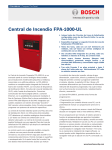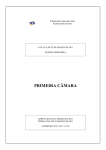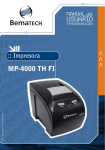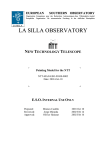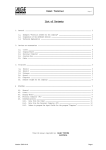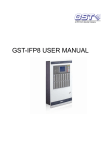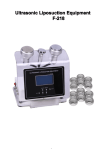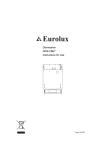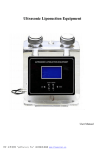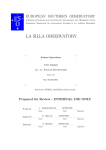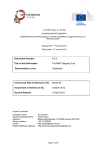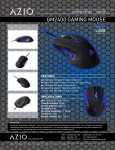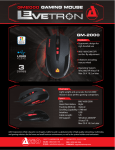Download LSO-MAN-ESO-40100-00..
Transcript
EUROPEAN SOUTHERN OBSERVATORY Organisation Européenne pour des Recherches Astronomiques dans l’Hémisphère Austral Europäische Organisation für astronomische Forschung in der südlichen Hemisphäre New Technology Telescope MOS Operations LSO-MAN-ESO-40100-0005 Issue 2.1 Data 16/06/00 Ph. Gitton/S. Brillant 16/06/00 Prepared..................................................................................................... Name Date Signature O. Hainaut 25/06/00 Approved........................................................................................ Name Date Signature O. Hainaut Released ..................................................................................................... Name Date Signature VLT PROGRAMME * TELEPHONE: +49 89 32006-0 * FAX: +49 89 320 2362 2 MOS Operations- 2.1 LSO-MAN-ESO-40100-0004 Mos Operations 2.1 1 LSO-MAN-ESO-40100-0005 3 Scope and relevants documents. This document describe the operations of the Multi Object Spectroscopy for the ESO Multi Mode Instrument (EMMI) both in term of maintenance and observation. It is intended for NTT TIO and operations engineer and for NTT support astronomer. The relevant references documents are: • EMMI User Manual LSO-MAN-ESO-40100-0001 October 1999 • EMMI Setup Manual 2 Multi Object Spectroscopy system 2.1 Global functionality The MOS sub-system in EMMI is a piece of equipment that is capable of punching a serie of slits on a MOS plate, in order to only let through light from certain parts of the field. These slits can be of different sizes (width & length) according to the observation requirements. The punching machine is located inside EMMI so that it can punch any plate installed on the star plate wheel. Chronologically, a virgin plate is installed moving the wheel to load position, then the wheel goes to punching position and finally to observing position. The starplate wheel is able to hold up to 4 different MOS plates, positions marked 2 to 5. 2.2 Operation Steps The following steps are necessary to do a MOS plate observation: • Take an exposure of the observation field of interest. • Using Midas xmos context, mark down the places on the exposure where the slits are desired and create a file containing the corresponding punch positions. • Physically mount an empty plate on a given position of the MOS starplate. • From EMMI OS GUI call up the MOS tool GUI. • Load the file containing the punch positions. • Punch the plate • Take an exposure to check that the plate has been correctly punched and measure the positions of the three references slitlets. At that point the plate is ready to be used for the scientific observations. Mos Operations 2.1 2.3 LSO-MAN-ESO-40100-0005 4 Available punch heads Table 1: MOS punching heads characteristics Punch Id width (microns) height (microns) width (arcsec) height (arcsec) #1 150 1000 0.80 5.3 #4, #5 & #8 190 1600 1.02 8.6 #6 & #7 249 1600 1.34 8.6 #3 350 1590 1.87 8.5 2.4 Safety Measures • Make sure that the punching head installed is the one that is intended to be used, and that its configuration parameters are set up properly. • Before trying a MOS plate operation, make sure that EMMI configuration corresponds to reality. It is reminded that only MOS plates should be declared as punchable. (a plate is punchanle if it is called MOS#1, MOS#2, MOS#3 or MOS#4 in the EMMI configuration panel.) Mos Operations 2.1 3 LSO-MAN-ESO-40100-0005 5 MOS operation 3.1 3.1.1 Setup of the instrument MOS plate mounting Use EMMI configuration panel. To put the desired location of the starplate wheel on the load point, do the following: • select the slit position number and press the move to load button With a marker write on a virgin MOS plate the name of the astronomer,the date and the wheel position then physically mount the MOS plate on the position located at the load point. Then update the configuration doing the folllowing. • click the slit widget and choose a MOS#n plate. • select the position number and not aligned option, then press Enter Starplate button Check the display on the right part of the GUI to check that the configuration is correct. When the plate is removed after the observations give it to the astronomer. 3.1.2 Punching head mounting Use EMMI configuration panel. Install the requested punching head inside EMMI. In order to do that follow the following procedure: • Press EMMI emergency stop button at the center of EMMI cover. • Get the requested punching head from cupboard #1. • Open the red EMMI cover. • Unplug the connecting cable of the punching head (function #25). • Rotate the button on the punching head by 90 deg to release the punching head, then pull it out carefully. • Carefully put in the new head and once in position rotate the button on the punching head by 90 deg to lock it in position. • Plug in the connecting cable of the punching head (function #25) • Install MOS plates into Starplate wheel like normal slits (Except Declaration and Alignment). • Close the EMMI cover. • • • • Declare MOS plates into EMMI configuration panel. Adjust punching offset (MOS operation Manual , 2.1.3) Click Backup under File submenu. Release the emergency stop button. Mos Operations 2.1 LSO-MAN-ESO-40100-0005 6 Then update the configuration: • select the head number and press enter head button IMPORTANT: At that point, execute emiBackup command to save your configuration (this command can be executed directly from the emouifConfig panel as an option in the File pull-down menu or by typing emiBackup in an xterm window). 3.1.3 Offsets adjustment Once the MOS plates have been loaded and the requested punching head has been mounted, the setup procedure consist in adjusting the punching offsets. Those offsets are set so that the punches performed on the plate are done exactly at the place where they were requested. To this end, do the following: • Start xmos Midas context on wg5oh, in the visitor account. • Define a mask containing 2 short slits at two edges of the punchable area. • Send the mask. • From wemmi (directory /vltdata/tmp), ftp the file *.mask from wg5oh. This file is located in the sub-directory EMOS-MASKS and its name is given in the Midas window at the moment the ‘save mask’ command is executed. • At that point, follow the punching procedures detailed in the next section. • Once the plate is punched, check the punching by taking an exposure following the procedure given in the specific MOS manual. Load the image from the directory / data/raw/YYYY-MM-DD on wg5oh and overlay the mask file that served to define the punches. Using the zoom option, measure precisely the offsets (if any) in pixels between the hole and the defined slit. The error in pixel can be converted into error in encoder units by using the following formulae: error_X (enc) = error_X(pixel) * 12.67 error_Y(enc) = error_Y(pixel) * 6.34 For the sign of those quantities, apply the following empirical rules: If the punched slit is on the right of the defined slit, error_X(enc) < 0. If the punched slit is lower than the defined slit, error_Y(enc) < 0. • At that point you can modify in the emmi configuration panel the current punching offsets by adding to them the errors previously calculated. At that point you should repeat the process to make sure that the slits punched are located where they were intended to. • Once the adjustment is finished, execute emiBackup to save the configuration. • Finally write in your daily log book the punching offsets values you found as well as the punching head ID for trend analysis purpose. Mos Operations 2.1 LSO-MAN-ESO-40100-0005 7 As an example, these offsets have been adjusted on July 01st, 1997 when using punching head #7 and we got: offset_X (enc) = -1488 offset_Y (enc) = -361 IMPORTANT: As you have punched a plate to perform the setup, always remember to replace it with a new one and update the EMMI configuration panel. 3.2 3.2.1 Plate punching The MOS User Interface From EMMI OS GUI under the tools menu, select the MOS option. This action will pop the MOS GUI up. Mos Operations 2.1 LSO-MAN-ESO-40100-0005 Table 2: MOS GUI Widget elements Widget Element Description Position To select wheel position were the plate to be punched will be loaded (only position 2 to 5 are available for holding plates. Position 1 is allways free). File Name of file containing the coordinates of positions were to punch Overpunch/No_overpunch To enablle or disable the possibility to punch a plate already punched Step This element tells how many slits have already been punched Total This show how many slits poisitions will be punched STRX position encoder position of STRX EMMI function STRY position encoder position of STRY EMMI function Position starplate position Punchable show if a position is available for punching Punched show is this position was already punched Mask File name shows name of file containing the data of positions used to punch this particular plate Date Date when this plate was punched Time Time when this plate was punched Online to set MOS function to online. Initialize Load Load file with position data. name of this file was given in the file element. 8 Mos Operations 2.1 LSO-MAN-ESO-40100-0005 9 Table 2: MOS GUI Widget elements Widget Element Description Start Start the punching procedure Stop Stop punching (punching can not be restarted again) Standby Set state of MOS unit to standby (disable STRX, STRY, STRZ functions) 3.2.2 Operational procedure Put the module ONLINE by pressing the “Online” button at the lower part of the MOS GUI. Wait for the initialization of all units (the state of strx stry strz units should change to ONLINE). One can monitor the process by checking that Y (then X) coordinates vary up and down. Enter the name of the file containing the position of the slits to be punched by pressing the “Load” button. This files should be in the following directory in order to be punched. /data/INSROOT/SYSTEM/MOS altough as of june 2000 the following directory has to be used /vltdata/tmp The files will have an extension “.mask” On the MOS GUI select the position that will be punched. In case that the plate is already punched and new slits need to be added, select the “over-punch” option. Start the punching procedure by pressing the “Start” button. The punching procedure has the following steps: • reads from the input file the number of positions of slits to be punched and updates the Total widget. • moves the starplate to the punching position • moves X and Y arm of the punching unit to the first set of coordinates • punches a slit Mos Operations 2.1 LSO-MAN-ESO-40100-0005 10 • increments the Step counter widget • goes to next punching position until all slits have been punched. (i.e. Step count will be equal to Total count) In case you want to interrupt the punching process before it finishes, press “Stop” button. Once all slits have been punched, and if no other plate has to be punched put the MOS module to standby by pressing the button “Standby”. Check that state of strx stry strz units change to STANDBY. Then execute an emmiBackup (cf 2.1.2) Note: This is not available in the current situation and should be fixed by the next VLT software release.. 3.3 Check the punching The plate that has been punched should be examined to make sure that all the slits have been done. This cannot be made directly as once punched, the MOS plate cannot be removed from the starplate wheel (the alignment would be lost as warned in section 1.4). Therefore the check has to be done by taking an exposure with an internal calibration lamp. This can be done using the suitable calibration template (RILDCT07). The image you get should contain all the slits previously defined. For an easier check, display, on wg5oh, the image ( that should be in the directory /data/raw/YYYY-MM-DD, where YYYY-MM-DD represent the date of today from 12am UT to 12 am UT) into the xmos context and overlay the mask that served to define the pucnh. If the image is slightly rotated from the mask drawing, check emmi configuration panel: the mos position should be restored to aligned with one of the following offsets position 2 = 392 position 3 = 576 position 4 = 674 position 5 = 710 However due to the new procedure for the positioning of the star into the slitets that now allow to take into account an eventual rotation of the plate, this problem is not as critical as it was before and it is even possible to use again a plate even after she has been out of EMMI only if used in the same position of the starplate. 3.4 Trouble shooting The troubles you might run into can be divided into 2 classes; the one that have never been reported before and the ones that are old friends of us (altough we are chasing them). A list is given here of those known problems and a suggested workaround. • When starting the punch, a pop up window appears indicating that the starplate function (STAP) cannot be moved or gave a time out. It is likely that one of the MOS plate installed has not been put correctly in position and prevent the motion of the starplate wheel. To solve the problem, open EMMI and reposition the MOS plate. Mos Operations 2.1 LSO-MAN-ESO-40100-0005 11 • When punching a MOS plate, the process suddenly stalls after having punched some slits. If the display of STAP interlock on the MOS interface indicates ‘Lock pin OUT and STRY parked, the workaround is to restart the punching (this is a quite common situation). • If you got an error at some point and the STAP interlock does not display the previous message, it is very likely that an HW interlock is set (either the one of the lock pin or the one of the STRY unit). You have to go up in the EMMI room, switch on the leds on the electronic board above EMMI and look at the leds corresponding to the STRX and STRY motors. If one of those 2 leds is OFF, an HW interlock is set. In this case, the handset has to be used to drive manually STRY to trigger the HW switch (the interlock is set when the led is switched OFF). 3.5 3.5.1 Summary of operations Setup Here are the steps to be followed when one is performing a setup: • Install the virgin MOS plates • Install the requested punch head • • • • Update EMMI configuration control (starplates and punch head) Backup the EMMI configuration Adjust the punching parameters Re-install a virgin plate and update the EMMI configuration • Backup the EMMI configuration • Log the adjusting parameters on your daily log Plate punching • Start MOS user interface • Put online the MOS sub-system • Perform the punching • Take a calibration exposure to make sure the punching process was successful Mos Operations 2.1 4 LSO-MAN-ESO-40100-0005 12 MOS SW maintenance 4.1 MOS Offset calculation The requirement is that the slit punched should be aligned with the columns of the detector once the MOS plate is in the observing position. To ensure this the mosOffset should be adjusted. This operation is only required when either the CCD or the starplate are dismounted. Here follows a procedure to measure and calculate this offset: • Punch a plate loading a file that will contain coordinates which will vary just in y, while x is maintained fixed. • The easiest to perform this step is to define using xmos MIDAS context a mask containing a single long slit from top to bottom of the punchable area. • Take an exposure with the telescope room lights on, using this plate. (The reference light can also be used). • Call Midas with “inmidas” and give the following commands: • indisk/fits ONTT....fits mos (where ONTT....fits is the name of the file created by emmi) • load mos cu=f,i sc=fu • center/iqe With this command you get the upper and lower limit of the slit. • Now we can calculate the difference in position between upper and lower part • take the difference between the two center values in pixels like diff = (Xlow - Xup)/(Yup - Ylow) • this difference gives the offset using the following formula: tan (angle) = diff/1000 angle = arctan(diff/1000) deg. Since 1 deg = 1000enc units then offset = angle*1000 enc (the offset is positive if the slit image is inclined as 11:25) • new_mosOffset = old_mosOffset - offset where old_mosOffset can be read from the database issuing the command: getval stap,mosOffset • Load new mosOffset value on MOS with: • setval stap,mosOffset,xxxx (where new_mosOffset) xxxxx is the calculated offset -> Mos Operations 2.1 LSO-MAN-ESO-40100-0005 13 • check that new value was correctly loaded with getval stap.mosOffset or with getconf stap,true Check that the offset was correctly calculated repeating the procedure with a slit which is on the same plate but shifted to one side: • punch a new slit on the same plate using the “over-punch” option. • take a new exposure with this new slit check the alignment again • if OK. Save the configuration with “emiBackup” A reference value has been measured on July 01st, 1997 (mosOffset = 215374) corresponding to an alignment of the slit of +0.4 pix/1000 pix clearly within specifications. 4.2 Reset of punching counter It might happen that a punch head breaks during operation. As there is an internal counter that keeps track of the cumulative number of punches performed by each head, this counter should be reset to 0 for the given head (let’s name p the id of this head). Here is the command that allows you to read first the value and then reset it: dbRead “@lemmi:emidevServer:motors:strz.values(p+1,4)” dbWrite “@lemmi:emidevServer:motors:strz.values(p+1,4)” 0 The counters of all the punching heads available can be also checked using the ccsei message window on wemmi by selecting lemmi environment and emilcuServer process. Then issue the following command to get the data you are interested in: getconf strz,true The line count correspond to the number of punches performed by a given punch head. Be careful as the first number corresponds to punch id 0 which does not exist, and then 1, 2 ,3 ..... ___oOo___ Mos Operations 2.1 LSO-MAN-ESO-40100-0005 14 Mos Operations 2.1 LSO-MAN-ESO-40100-0004 1 1 Scope and relevants documents. 3 2 Multi Object Spectroscopy system 3 2.1 2.2 2.3 2.4 Global functionality. . . . . . . . . . . . . . . . . . . . . . . . . . . . . . . . . . . . . . . . . . . . . . . . . . . . . . . . . . . . . 3 Operation Steps . . . . . . . . . . . . . . . . . . . . . . . . . . . . . . . . . . . . . . . . . . . . . . . . . . . . . . . . . . . . . . . . 3 Available punch heads . . . . . . . . . . . . . . . . . . . . . . . . . . . . . . . . . . . . . . . . . . . . . . . . . . . . . . . . . . 4 Safety Measures . . . . . . . . . . . . . . . . . . . . . . . . . . . . . . . . . . . . . . . . . . . . . . . . . . . . . . . . . . . . . . . . 4 3 MOS operation 3.1 3.2 3.3 3.4 3.5 Setup of the instrument. . . . . . . . . . . . . . . . . . . . . . . . . . . . . . . . . . . . . . . . . . . . . . . . . . . . . . . . . . 5 3.1.1 MOS plate mounting. . . . . . . . . . . . . . . . . . . . . . . . . . . . . . . . . . . . . . . . . . . . . . . . . . . . . . 5 3.1.2 Punching head mounting. . . . . . . . . . . . . . . . . . . . . . . . . . . . . . . . . . . . . . . . . . . . . . . . . . 5 3.1.3 Offsets adjustment. . . . . . . . . . . . . . . . . . . . . . . . . . . . . . . . . . . . . . . . . . . . . . . . . . . . . . . . 6 Plate punching . . . . . . . . . . . . . . . . . . . . . . . . . . . . . . . . . . . . . . . . . . . . . . . . . . . . . . . . . . . . . . . . . 7 3.2.1 The MOS User Interface . . . . . . . . . . . . . . . . . . . . . . . . . . . . . . . . . . . . . . . . . . . . . . . . . . . 7 3.2.2 Operational procedure . . . . . . . . . . . . . . . . . . . . . . . . . . . . . . . . . . . . . . . . . . . . . . . . . . . . 9 Check the punching. . . . . . . . . . . . . . . . . . . . . . . . . . . . . . . . . . . . . . . . . . . . . . . . . . . . . . . . . . . . 10 Trouble shooting . . . . . . . . . . . . . . . . . . . . . . . . . . . . . . . . . . . . . . . . . . . . . . . . . . . . . . . . . . . . . . 10 Summary of operations. . . . . . . . . . . . . . . . . . . . . . . . . . . . . . . . . . . . . . . . . . . . . . . . . . . . . . . . . 11 3.5.1 Setup . . . . . . . . . . . . . . . . . . . . . . . . . . . . . . . . . . . . . . . . . . . . . . . . . . . . . . . . . . . . . . . . . . 11 4 MOS SW maintenance 4.1 4.2 5 12 MOS Offset calculation . . . . . . . . . . . . . . . . . . . . . . . . . . . . . . . . . . . . . . . . . . . . . . . . . . . . . . . . . 12 Reset of punching counter . . . . . . . . . . . . . . . . . . . . . . . . . . . . . . . . . . . . . . . . . . . . . . . . . . . . . . 13
















